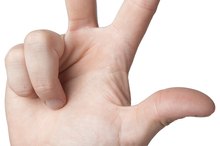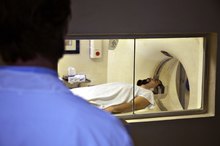Signs & Symptoms of Pinched Nerves in the Arm & Neck
Pinched nerves cause signs and symptoms that can significantly impact your daily tasks. According to the U.S. Department of Health and Human Services, approximately 20 million people have some type of nerve damage in their arms or legs 3. (ref 4, pg 1) Nerves can also be pinched as they come out of your spine. According to a study published in 2015 by "Medicine," 85 people out of every 100,000 have pinched nerves in the neck that cause symptoms into the arm. (ref 6, pg 2) These conditions can cause pain, tingling, numbness, decreased reflexes and weakness.
If you are experiencing serious medical symptoms, seek emergency treatment immediately.
Pain
Pain is the most common symptom associated with pinched nerves. According to a research review performed by "North American Spine Society," 99 percent of people with a pinched nerve in the neck complained of arm pain.
(ref 1, pg 12) Nerve pain is often worse at night, making it difficult to sleep.
(ref 4, pg 5) Pinched nerves can also make your skin more sensitive to the touch, further increasing your pain.
(same ref) Pinched nerves in the neck can cause pain in the neck, shoulder blade, arm and hand. Less commonly, headaches and chest pain can occur. (ref 1, pg 12) Nerves that are pinched further down the arm will cause pain specifically where that nerve is located.
- Pain is the most common symptom associated with pinched nerves.
- ref 4, pg 5) Pinched nerves can also make your skin more sensitive to the touch, further increasing your pain.
- (
Tingling and Numbness
How to Relieve Arm Pain Caused by a Pinched Nerve
Learn More
Sensory nerves give you the ability to feel things.
When sensory nerves are pinched, your sense of touch can be disrupted. According to "North American Spine Society," 85 percent of people with a pinched nerve in the neck complained of decreased sensation.
(ref 1, pg 12) Tingling can occur along the nerve that is pinched in your neck or arm, causing a sensation like the area is "falling asleep." Tingling may be constant or come and go. Sensory nerve damage can also cause numbness.
This can cause you to feel like you are wearing gloves when you touch something with your affected hand. You might have difficulty determining whether an object is sharp or dull, or whether water is hot or cold. As a result, decreased sensation can lead to injury.
- Sensory nerves give you the ability to feel things.
- ref 1, pg 12) Tingling can occur along the nerve that is pinched in your neck or arm, causing a sensation like the area is "falling asleep."
Decreased Reflexes
If you've ever had a check-up, chances are you've had your reflexes checked. According to "North American Spine Society," over 70 percent of people with a pinched nerve in the neck had decreased response in their arm reflexes. (ref 1, pg 12) When a particular tendon in your arm is tapped with a reflex hammer, a message is sent to your spinal cord causing the muscle to contract. Depending on the reflex tested, this will normally cause a quick movement in your elbow or wrist. When nerves are pinched in the neck, these reflexes can decrease. Nerves that are pinched further down your arm will not affect your reflexes.
- If you've ever had a check-up, chances are you've had your reflexes checked.
- Depending on the reflex tested, this will normally cause a quick movement in your elbow or wrist.
Weakness
Numbness & Shocking in the Fingers
Learn More
Motor nerves power your muscles.
A pinched motor nerve can cause weakness in your arm muscles. According to "North American Spine Society," 68 percent of people with a pinched nerve in the neck had weakness in muscles powered by the affected nerve. (ref 1, pg 12) Weakness can also occur when nerves are pinched in the arm. You might notice that you are dropping things or have difficulty with tasks such as opening a jar. Motor nerve damage can also cause muscle twitching or painful muscle cramps. (ref 4, pg 5) Your muscle might shrink in size. In severe cases, the muscle can become paralyzed.
- Motor nerves power your muscles.
- ref 1, pg 12) Weakness can also occur when nerves are pinched in the arm.
Precautions and Warnings
See your doctor if you have signs or symptoms of a pinched nerve. Many conditions that cause pinched nerves can be successfully treated with antiinflammatory or prescription medications, exercises and physical therapy. (ref 5, pg 4) If conservative treatment for a pinched nerve is unsuccessful, surgery might be required.
Related Articles
References
- North American Spine Society: Evidence-Based Clinical Guidelines for Multidisciplinary Spine Care
- American Family Physician: Cervical Radiculopathy: Nonoperative Management of Neck Pain and Radicular Symptoms
- U.S. Department of Health & Human Services: National Guideline Clearinghouse: Carpal Tunnel Syndrome
- Medicine: Dimensions Underlying Measures of Disability, Personal Factors, and Health Status in Cervical Radiculopathy
- Hochman MG, Zilberfarb JL. Nerves in a pinch: imaging of nerve compression syndromes. Radiol Clin North Am. 2004;42(1):221-45. doi:10.1016/S0033-8389(03)00162-3
- NIH National Institute of Neurological Disorders and Stroke. Pinched nerve information page. Updated March 27, 2019.
- AdventHealth Medical Group. Cauda equina syndrome.
- AAOS OrthoInfo. Cervical radiculopathy (pinched nerve). Updated June 2015.
- Dimitrova A, Murchison C, Oken B. Acupuncture for the treatment of peripheral neuropathy: A systematic review and meta-analysis. J Altern Complement Med. 2017;23(3):164-179. doi:10.1089/acm.2016.0155
- Conger A, Cushman DM, Speckman RA, Burnham T, Teramoto M, McCormick ZL. The Effectiveness of Fluoroscopically Guided Cervical Transforaminal Epidural Steroid Injection for the Treatment of Radicular Pain; a Systematic Review and Meta-analysis. Pain Med. 2019 Jun 10. pii: pnz127. doi:10.1093/pm/pnz127 [Epub ahead of print]
- Keating L, Treanor C, Sugrue J, Meldrum D, Bolger C, Doody C. A randomised controlled trial of multimodal physiotherapy versus advice for recent onset, painful cervical radiculopathy - the PACeR trial protocol. BMC Musculoskelet Disord. 2019 Jun 1;20(1):265. doi:10.1186/s12891-019-2639-4
Writer Bio
Erica Roth has been a writer since 2007. She is a member of the Society of Professional Journalists and was a college reference librarian for eight years. Roth earned a Bachelor of Arts in French literature from Brandeis University and Master of Library Science from Simmons College Graduate School of Library and Information Science. Her articles appear on various websites.








